Moran M.J., Shapiro H.N. Fundamentals of Engineering Thermodynamics
Подождите немного. Документ загружается.

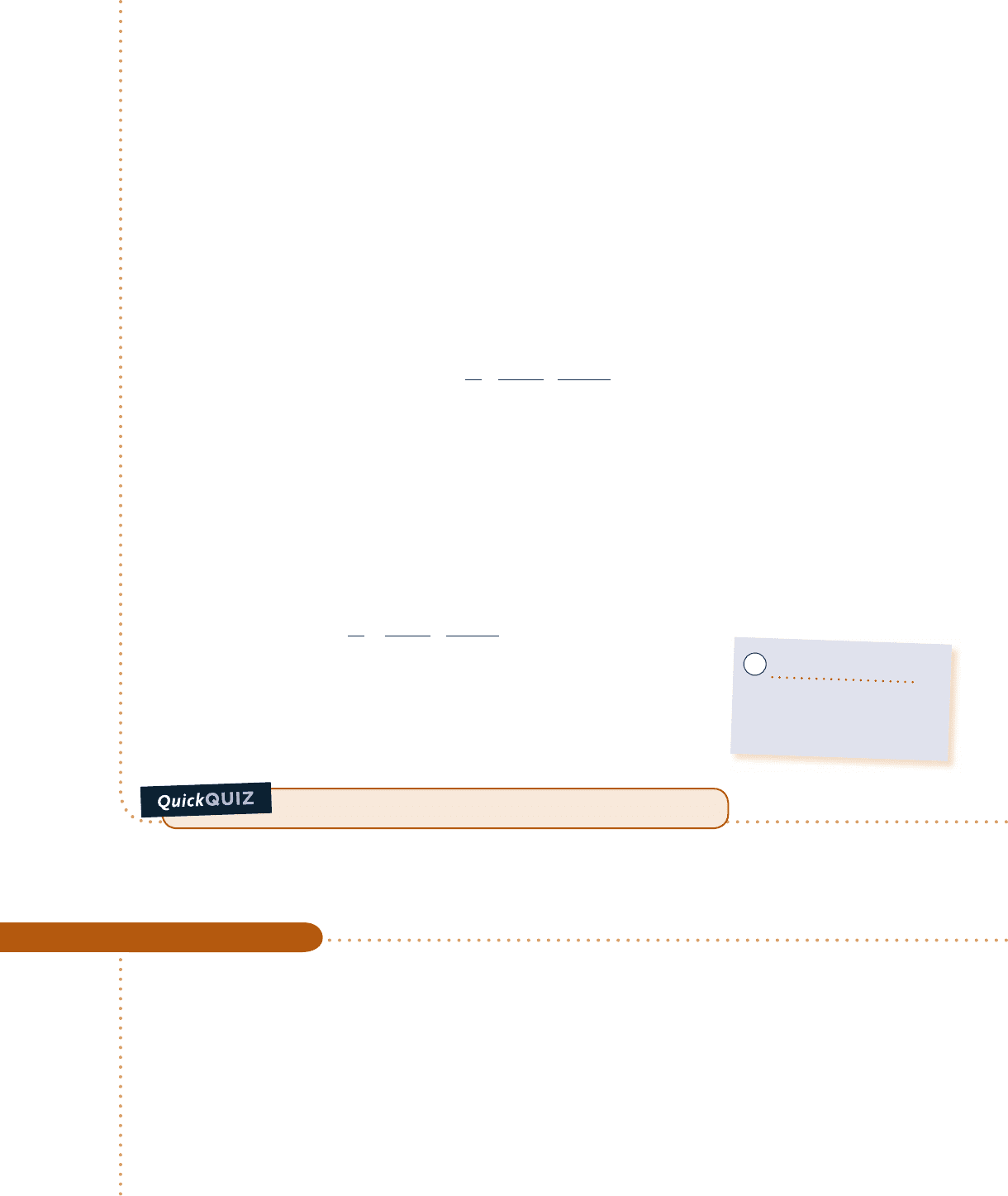
Engineering Model:
1.
The turbine and the pump can each be analyzed as a control volume at steady state.
2. The turbine and pump operate adiabatically and each has an isentropic efficiency of 85%.
3. Kinetic and potential energy effects are negligible.
4. Only 69% of the exergy entering the plant with the fuel remains after accounting for the stack loss and
combustion exergy destruction.
5. T
0
5 228C, p
0
5 1 atm.
Analysis: The rate of exergy destruction can be found by reducing the exergy rate balance or by use of the
relationship E
#
d
5 T
0
s
#
cv
, where s
#
cv
is the rate of entropy production from an entropy rate balance. With either
approach, the rate of exergy destruction for the turbine can be expressed as
E
#
d
5 m
#
T
0
1s
2
2 s
1
2
From Table A-3, s
1
5 5.7432 kJ/kg ? K. Using h
2
5 1939.3 kJ/kg from the solution to Example 8.2, the value of
s
2
can be determined from Table A-3 as s
2
5 6.2021 kJ/kg ? K. Substituting values
E
#
d
5 14.449 3 10
5
kg
/
h21295 K216.2021 2 5.743221kJ
/
kg ? K2
5 a0.602 3 10
8
kJ
h
b`
1 h
3600 s
``
1 MW
10
3
kJ
/
s
`5 16.72 MW
From the solution to Example 8.7, the net rate at which exergy is supplied by the cooling combustion gases
is 231.28 MW. The turbine rate of exergy destruction expressed as a percentage of this is (16.72/231.28)(100%) 5
7.23%. However, since only 69% of the entering fuel exergy remains after the stack loss and combustion exergy
destruction are accounted for, it can be concluded that 0.69 3 7.23% 5 5% of the exergy entering the plant with
the fuel is destroyed within the turbine. This is the value listed in Table 8.4.
Similarly, the exergy destruction rate for the pump is
E
#
d
5 m
#
T
0
1s
4
2 s
3
2
With s
3
from Table A-3 and s
4
from the solution to Example 8.7
E
#
d
5 14.449 3 10
5
kg
/
h21295 K210.5957 2 0.592621kJ
/
kg ? K2
5 a4.07 3 10
5
kJ
h
b `
1 h
3600 s
``
1 MW
10
3
kJ
/
s
`5 0.11 MW
Expressing this as a percentage of the exergy entering the plant as calculated above,
we have (0.11/231.28)(69%) 5 0.03%. This value is rounded to zero in Table 8.4.
The net power output of the vapor power plant of Example 8.2 is 100 MW.
Expressing this as a percentage of the rate at which exergy is carried into the
plant with the fuel, (100/231.28)(69%) 5 30%, as shown in Table 8.4.
Ability to…
❑
perform exergy analysis of a
power plant turbine and pump.
✓
Skills Developed
What is the exergetic efficiency of the power plant? Ans. 30%.
The following example illustrates the exergy analysis of the condenser of the case
study vapor power plant.
Vapor Cycle Exergy Analysis—Condenser
c c c c EXAMPLE 8.9 c
The condenser of Example 8.2 involves two separate water streams. In one stream a two-phase liquid–vapor
mixture enters at 0.008 MPa and exits as a saturated liquid at 0.008 MPa. In the other stream, cooling water
enters at 158C and exits at 358C. (a) Determine the net rate at which exergy is carried from the condenser by
the cooling water, in MW. Express this result as a percentage of the exergy entering the plant with the fuel.
(b) Determine for the condenser the rate of exergy destruction, in MW. Express this result as a percentage of
the exergy entering the plant with the fuel. Let T
0
5 228C and p
0
5 1 atm.
8.6 Case Study: Exergy Accounting of a Vapor Power Plant 473
c08VaporPowerSystems.indd Page 473 7/12/10 7:00:58 AM user-s146 c08VaporPowerSystems.indd Page 473 7/12/10 7:00:58 AM user-s146 /Users/user-s146/Desktop/Merry_X-Mas/New/Users/user-s146/Desktop/Merry_X-Mas/New
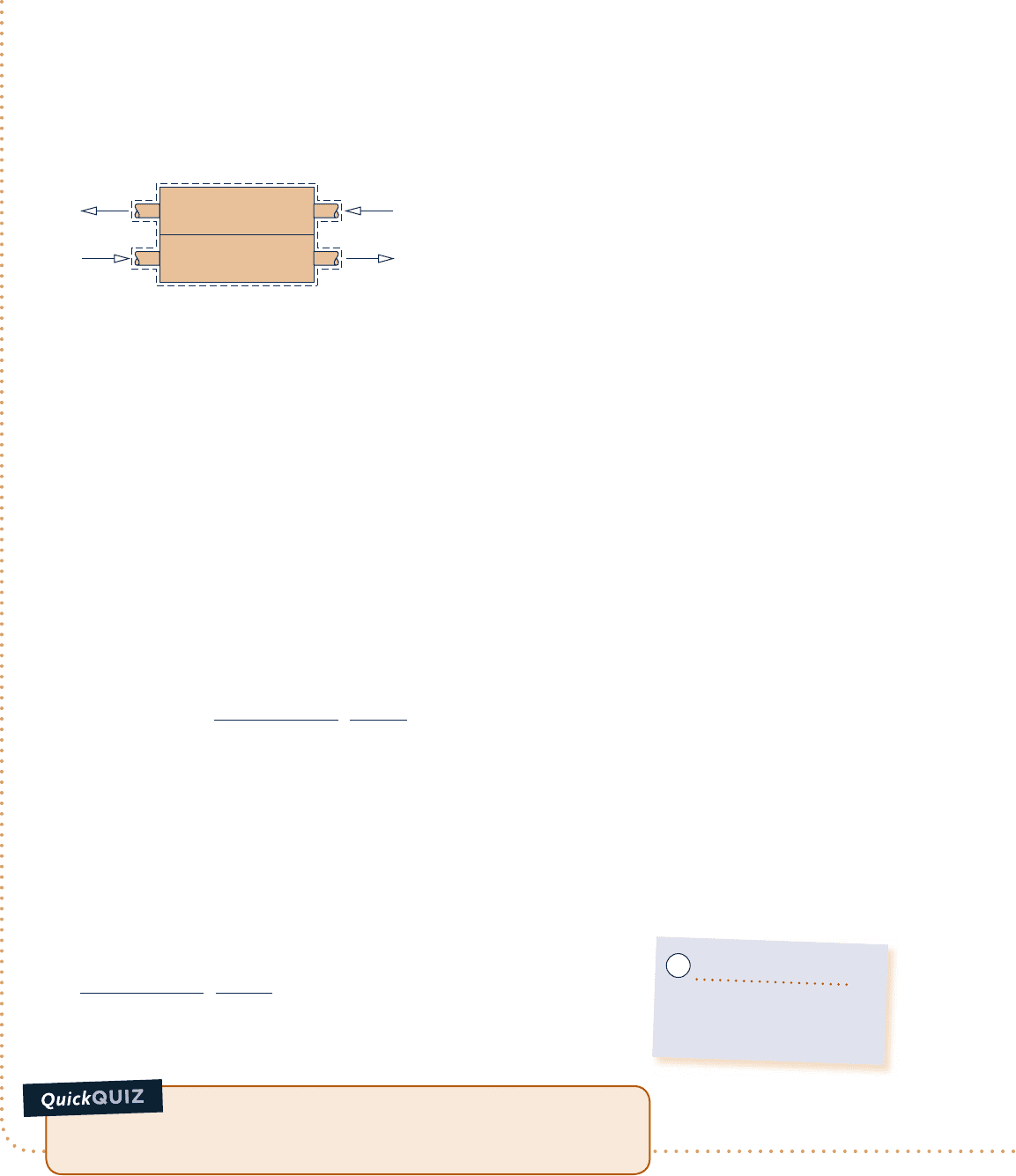
474 Chapter 8 Vapor Power Systems
Saturated
liquid,
0.008 MPa
Liquid,
15°C
Two-phase
liquid-vapor mixture,
0.008 MPa
Liquid,
35°
C
2
e
3
i
Fig. E8.9
Engineering Model:
1.
The control volume shown on the accompanying figure operates at steady state with
Q
#
cv
5 W
#
cv
5 0.
2. Kinetic and potential energy effects can be ignored.
3. Only 69% of the fuel exergy remains after accounting for the stack loss and combustion exergy destruction.
4. T
0
5 228C, p
0
5 1 atm.
Analysis:
(a)
The net rate at which exergy is carried out of the condenser can be evaluated by using Eq. 7.18:
£
net rate at which exergy
is carried out by the
coolin
g
water
§5 m
#
cw
1e
fe
2 e
fi
2
5 m
#
cw
3
h
e
2 h
i
2 T
0
1
s
e
2 s
i
24
where m
#
cw
is the mass flow rate of the cooling water from the solution to Example 8.2. With saturated liquid values
for specific enthalpy and entropy from Table A-2 at the specified inlet and exit temperatures of the cooling water
m
#
cw
1
e
fe
2 e
fi
2
5
1
9.39 3 10
6
kg
/
h
231
146.68 2 62.99
2
kJ
/
kg 2
1
295 K
21
0.5053 2 0.2245
2
kJ
/
kg ? K
4
5
8.019 3 10
6
kJ
/
h
Z
3600 s
/
h
Z
`
1 MW
10
3
kJ
/
s
`5 2.23 MW
Expressing this as a percentage of the exergy entering the plant with the fuel, we get (2.23/231.28)(69%) 5 1%.
This is the value listed in Table 8.4.
(b) The rate of exergy destruction for the condenser can be evaluated by reducing the exergy rate balance. Alterna-
tively, the relationship E
#
d
5 T
0
s
#
cv
can be employed, where s
#
cv
is the time rate of entropy production for the condenser
determined from an entropy rate balance. With either approach, the rate of exergy destruction can be expressed as
E
#
d
5 T
0
3
m
#
1
s
3
2 s
2
2
1 m
#
cw
1
s
e
2 s
i
24
Substituting values
E
#
d
5 295
31
4.449 3 10
5
21
0.5926 2 6.2021
2
1
1
9.39 3 10
6
21
0.5053 2 0.2245
24
5
416.1 3 10
5
kJ
/
h
Z
3600 s
/
h
Z
`
1 MW
10
3
kJ
/
s
`5 11.56 MW
Expressing this as a percentage of the exergy entering the plant with the fuel,
we get (11.56/231.28)(69%) 5 3%. This is the value listed in Table 8.4.
Referring to data from Example 8.2, what percent of the energy
supplied to the steam passing through the steam generator is carried out
by the cooling water? Ans. 68.6%.
Ability to…
❑
perform exergy analysis of a
power plant condenser.
✓
Skills Developed
SOLUTION
Known:
A condenser at steady state has two streams: (1) a two-phase liquid–vapor mixture entering and condensate
exiting at known states and (2) a separate cooling water stream entering and exiting at known temperatures.
Find: Determine the net rate at which exergy is carried from the condenser by the cooling water stream and the
rate of exergy destruction for the condenser. Express both quantities in MW and as percentages of the exergy
entering the plant with the fuel.
Schematic and Given Data:
c08VaporPowerSystems.indd Page 474 7/12/10 7:01:00 AM user-s146 c08VaporPowerSystems.indd Page 474 7/12/10 7:01:00 AM user-s146 /Users/user-s146/Desktop/Merry_X-Mas/New/Users/user-s146/Desktop/Merry_X-Mas/New

This chapter begins with an introduction to power generation
that surveys current U.S. power generation by source and looks
ahead to power generation needs in decades to come. These
discussions provide context for the study of vapor power plants
in this chapter and gas power plants in Chap. 9.
In Chap. 8 we have considered practical arrangements for
vapor power plants, illustrated how vapor power plants are mod-
eled thermodynamically, and considered the principal irreversi-
bilities and losses associated with such plants. The main compo-
nents of simple vapor power plants are modeled by the Rankine
cycle.
In this chapter, we also have introduced modifications to the
simple vapor power cycle aimed at improving overall perfor-
mance. These include superheat, reheat, regeneration, super-
critical operation, cogeneration, and binary cycles. We have also
included a case study to illustrate the application of exergy anal-
ysis to vapor power plants.
The following checklist provides a study guide for this chap-
ter. When your study of the text and end-of-chapter exercises has
been completed you should be able to
c
write out the meanings of the terms listed in the margin
throughout the chapter and understand each of the related
concepts. The subset of key concepts listed below is particu-
larly important.
c
sketch schematic diagrams and accompanying T–s diagrams
of Rankine, reheat, and regenerative vapor power cycles.
c
apply conservation of mass and energy, the second law, and
property data to determine power cycle performance, including
thermal efficiency, net power output, and mass flow rates.
c
discuss the effects on Rankine cycle performance of varying
steam generator pressure, condenser pressure, and turbine
inlet temperature.
c
discuss the principal sources of exergy destruction and loss
in vapor power plants.
c CHAPTER SUMMARY AND STUDY GUIDE
c KEY ENGINEERING CONCEPTS
Rankine cycle, p. 433
thermal efficiency, p. 435
back work ratio, p. 435
ideal Rankine cycle, p. 437
superheat, p. 447
reheat, p. 447
supercritical, p. 448
regeneration, p. 453
open feedwater heater, p. 453
closed feedwater heater, p. 458
organic cycle, p. 464
binary vapor cycle, p. 464
cogeneration, p. 465
district heating, p. 465
exergy accounting, p. 468
c KEY EQUATIONS
h 5
W
#
t
/
m
#
2 W
#
p
/
m
#
Q
#
in
/
m
#
5
1h
1
2 h
2
22 1h
4
2 h
3
2
h
1
2 h
4
(8.5a) p. 435 Thermal efficiency for the Rankine cycle of Fig. 8.2
bwr 5
W
#
p
/
m
#
W
#
t
/
m
#
5
1h
4
2 h
3
2
1h
1
2 h
2
2
(8.6) p. 435 Back work ratio for the Rankine cycle of Fig. 8.2
a
W
#
p
m
#
b
s
< y
3
1p
4
2 p
3
2
(8.7b) p. 437 Approximation for the pump work of the ideal
Rankine cycle of Fig. 8.3
c EXERCISES: THINGS ENGINEERS THINK ABOUT
1. Many utility companies offer special rates for “green power.”
What does that mean?
2. Brainstorm some ways to use the cooling water exiting the
condenser of a large power plant.
3. What effects on a river’s ecology might result from a power
plant’s use of river water for condenser cooling?
4. Referring to Fig. 8.1a, what environmental impacts might
result from the two plumes shown on the figure?
5. What is a baseload power plant?
6. If Iceland completes its planned transition to using only renew-
able energy throughout its society by mid-century, what sig-
nificant changes in lifestyle will Icelanders have to tolerate?
7. What type of power plant produces the electricity used in
your residence?
8. What is the relationship between global climate change
and the hole in Earth’s ozone layer?
9. Why is it important for power plant operators to keep pipes
circulating water through plant components free from fouling?
Exercises: Things Engineers Think About 475
c08VaporPowerSystems.indd Page 475 7/12/10 7:01:58 AM user-s146 c08VaporPowerSystems.indd Page 475 7/12/10 7:01:58 AM user-s146 /Users/user-s146/Desktop/Merry_X-Mas/New/Users/user-s146/Desktop/Merry_X-Mas/New

476 Chapter 8
Vapor Power Systems
10. What is the difference between solar-concentrating and
solar-photovoltaic electricity generation?
11. Decades of coal mining have left piles of waste coal, or culm,
in many locations through the United States. What effects
does culm have on human health and the environment?
12. How do operators of electricity-generating plants detect
and respond to changes in consumer demand throughout
the day?
12. What is an energy orb?
PROBLEMS: DEVELOPING ENGINEERING SKILLS
Analyzing Rankine Cycles
8.1 Water is the working fluid in an ideal Rankine cycle. The
condenser pressure is 6 kPa, and saturated vapor enters the
turbine at 10 MPa. Determine the heat transfer rates, in kJ
per kg of steam flowing, for the working fluid passing
through the boiler and condenser and calculate the thermal
efficiency.
8.2 Water is the working fluid in an ideal Rankine cycle.
Superheated vapor enters the turbine at 10 MPa, 4808C, and
the condenser pressure is 6 kPa. Determine for the cycle
(a) the rate of heat transfer to the working fluid passing
through the steam generator, in kJ per kg of steam flowing.
(b) the thermal efficiency.
(c) the rate of heat transfer from the working fluid passing
through the condenser to the cooling water, in kJ per kg of
steam flowing.
8.3 Water is the working fluid in a Carnot vapor power cycle.
Saturated liquid enters the boiler at a pressure of 10 MPa,
and saturated vapor enters the turbine. The condenser
pressure is 6 kPa. Determine
(a) the thermal efficiency.
(b) the back work ratio.
(c) the heat transfer to the working fluid per unit mass
passing through the boiler, in kJ/kg.
(d) the heat transfer from the working fluid per unit mass
passing through the condenser, in kJ/kg.
8.4 Plot each of the quantities calculated in Problem 8.2
versus condenser pressure ranging from 6 kPa to 0.1 MPa.
Discuss.
8.5 Plot each of the quantities calculated in Problem 8.2
versus steam generator pressure ranging from 4 MPa to 20
MPa. Maintain the turbine inlet temperature at 4808C.
Discuss.
8.6 A Carnot vapor power cycle operates with water as the
working fluid. Saturated liquid enters the boiler at 1800 lbf/in.
2
,
and saturated vapor enters the turbine (state 1). The condenser
pressure is 1.2 lbf/in.
2
The mass flow rate of steam is 1 3 10
6
lb/h. Data at key points in the cycle are provided in the
accompanying table. Determine
(a) the thermal efficiency.
(b) the back work ratio.
(c) the net power developed, in Btu/h.
(d) the rate of heat transfer to the working fluid passing
through the boiler.
State p(lbf/in.
2
) h(Btu/lb)
1 1800 1150.4
2 1.2 735.7
3 1.2 472.0
4 1800 648.3
8.7 Water is the working fluid in an ideal Rankine cycle.
Saturated vapor enters the turbine at 16 MPa, and the
condenser pressure is 8 kPa. The mass flow rate of steam
entering the turbine is 120 kg/s. Determine
(a) the net power developed, in kW.
(b) the rate of heat transfer to the steam passing through
the boiler, in kW.
(c) the thermal efficiency.
(d) the mass flow rate of condenser cooling water, in kg/s,
if the cooling water undergoes a temperature increase of
188C with negligible pressure change in passing through the
condenser.
8.8 Water is the working fluid in a Carnot vapor power cycle.
Saturated liquid enters the boiler at 16 MPa, and saturated
vapor enters the turbine. The condenser pressure is 8 kPa.
The mass flow rate of steam entering the turbine is 120 kg/s.
Determine
(a) the thermal efficiency.
(b) the back work ratio.
(c) the net power developed, in kW.
(d) the rate of heat transfer from the working fluid passing
through the condenser, in kW.
8.9 Plot each of the quantities calculated in Problem 8.7
versus turbine inlet temperature ranging from the saturation
temperature at 16 MPa to 5608C Discuss.
8.10 Water is the working fluid in an ideal Rankine cycle. Steam
enters the turbine at 1400 lbf/in.
2
and 10008F. The condenser
pressure is 2 lbf/in.
2
The net power output of the cycle is
1 3 10
9
Btu/h. Cooling water experiences a temperature
increase from 608F to 768F, with negligible pressure drop, as
it passes through the condenser. Determine for the cycle
(a) the mass flow rate of steam, in lb/h.
(b) the rate of heat transfer, in Btu/h, to the working fluid
passing through the steam generator.
(c) the thermal efficiency.
(d) the mass flow rate of cooling water, in lb/h.
8.11 Plot each of the quantities calculated in Problem 8.10 versus
condenser pressure ranging from 0.3 lbf/in.
2
to 14.7 lbf/in.
2
Maintain constant net power output. Discuss.
c08VaporPowerSystems.indd Page 476 9/24/10 3:49:35 PM user-s146 c08VaporPowerSystems.indd Page 476 9/24/10 3:49:35 PM user-s146 /Users/user-s146/Desktop/Merry_X-Mas/New/Users/user-s146/Desktop/Merry_X-Mas/New
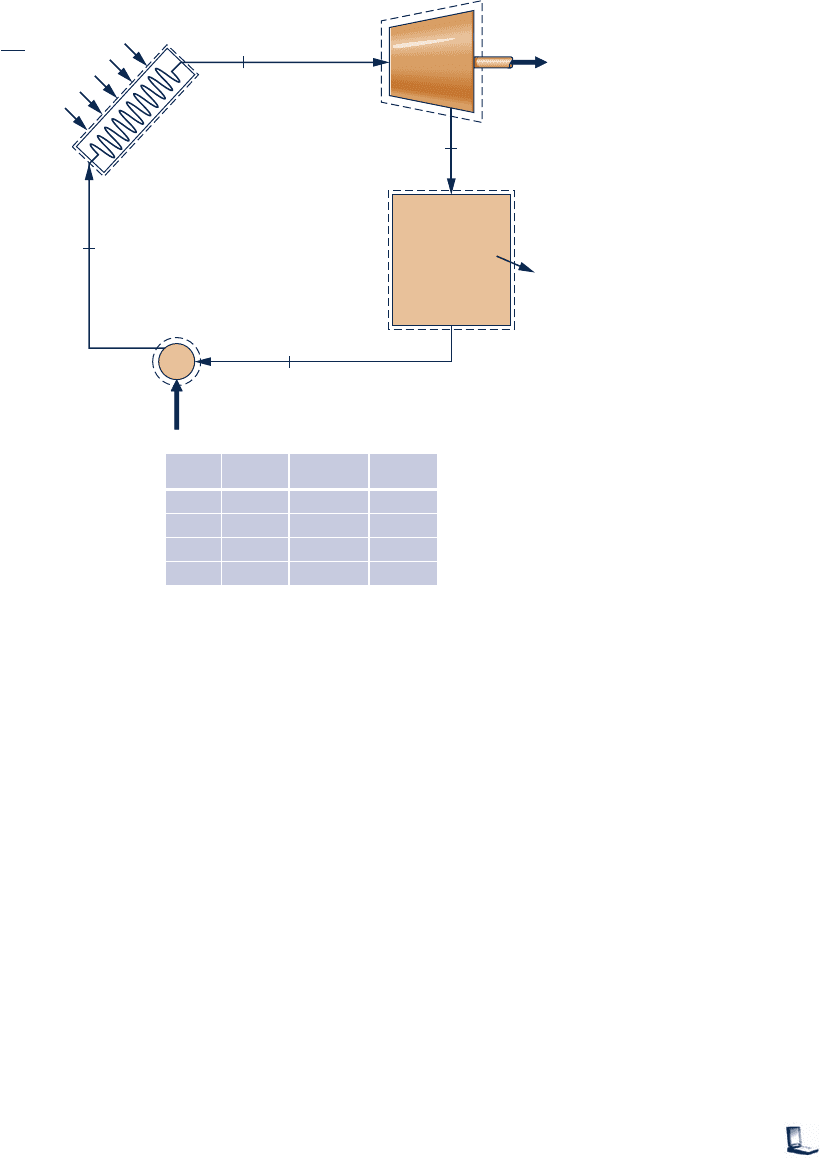
Problems: Developing Engineering Skills 477
Solar
collectors
Turbine
1
2
3
4
W
t
˙
Condenser
Q
out
˙
W
p
˙
Q
in
˙
= 0.3 kW/m
2
A
State
1
2
3
4
276.83
261.01
86.78
87.93
1
0.9952
0
—
h (kJ/kg) xp (bar)
18
7
7
18
Pump
Fig. P8.13
8.12 A power plant based on the Rankine cycle is under
development to provide a net power output of 10 MW. Solar
collectors are to be used to generate Refrigerant 22 vapor at
1.6 MPa, 508C, for expansion through the turbine. Cooling
water is available at 208C. Specify the preliminary design of
the cycle and estimate the thermal efficiency and the
refrigerant and cooling water flow rates, in kg/h.
8.13 Figure P8.13 provides steady-state operating data for a
solar power plant that operates on a Rankine cycle with
Refrigerant 134a as its working fluid. The turbine and pump
operate adiabatically. The rate of energy input to the
collectors from solar radiation is 0.3 kW per m
2
of collector
surface area, with 60% of the solar input to the collectors
absorbed by the refrigerant as it passes through the collectors.
Determine the solar collector surface area, in m
2
per kW of
power developed by the plant. Discuss possible operational
improvements that could reduce the required collector
surface area.
8.14 On the south coast of the island of Hawaii, lava flows
continuously into the ocean. It is proposed to anchor a
floating power plant offshore of the lava flow that uses
ammonia as the working fluid. The plant would exploit the
temperature variation between the warm water near the
surface at 1308F and seawater at 508F from a depth of 500 ft
to produce power. Figure P8.14 shows the configuration and
provides additional data. Using the properties of pure water
for the seawater and modeling the power plant as a Rankine
cycle, determine
(a) the thermal efficiency.
(b) the mass flow rate of ammonia, in lb/min, for a net power
output of 300 hp.
8.15 The cycle of Problem 8.3 is modified to include the effects
of irreversibilities in the adiabatic expansion and compression
processes. If the states at the turbine and pump inlets remain
unchanged, repeat parts (a)–(d) of Problem 8.3 for the
modified Carnot cycle with h
t
5 0.80 and h
p
5 0.70.
8.16 Steam enters the turbine of a simple vapor power plant
with a pressure of 10 MPa and temperature T, and expands
adiabatically to 6 kPa. The isentropic turbine efficiency is
85%. Saturated liquid exits the condenser at 6 kPa and the
isentropic pump efficiency is 82%.
(a) For T 5 5808C, determine the turbine exit quality and
the cycle thermal efficiency.
(b) Plot the quantities of part (a) versus T ranging from 580
to 7008C.
8.17 Water is the working fluid in a Rankine cycle. Superheated
vapor enters the turbine at 10 MPa, 4808C, and the condenser
pressure is 6 kPa. The turbine and pump have isentropic
efficiencies of 80 and 70%, respectively. Determine for the cycle
(a) the rate of heat transfer to the working fluid passing
through the steam generator, in kJ per kg of steam flowing.
c08VaporPowerSystems.indd Page 477 7/12/10 7:02:00 AM user-s146 c08VaporPowerSystems.indd Page 477 7/12/10 7:02:00 AM user-s146 /Users/user-s146/Desktop/Merry_X-Mas/New/Users/user-s146/Desktop/Merry_X-Mas/New
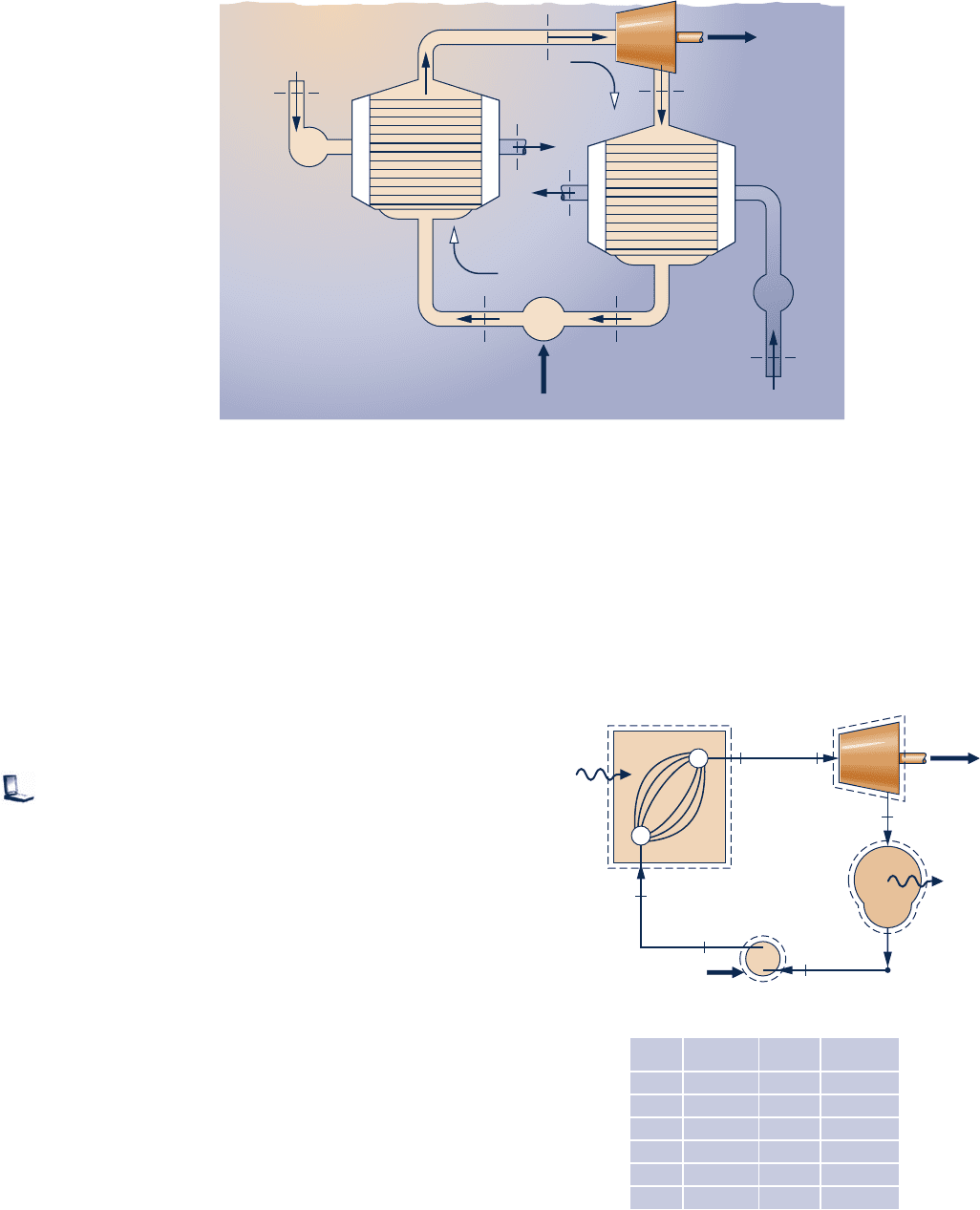
478 Chapter 8
Vapor Power Systems
(b) the thermal efficiency.
(c) the rate of heat transfer from the working fluid passing
through the condenser to the cooling water, in kJ per kg of
steam flowing.
8.18 Steam enters the turbine of a Rankine cycle at 16 MPa,
5608C. The condenser pressure is 8 kPa. The turbine and pump
each have isentropic efficiencies of 85%, and the mass flow
rate of steam entering the turbine is 120 kg/s. Determine
(a) the net power developed, in kW.
(b) the rate of heat transfer to the steam passing through the
boiler, in kW.
(c) the thermal efficiency.
Plot each of the quantities in parts (a)–(c) if the turbine and
pump isentropic efficiencies remain equal to each other but
vary from 80 to 100%.
8.19 Water is the working fluid in a Rankine cycle. Steam enters
the turbine at 1400 lbf/in.
2
and 10008F. The condenser pressure
is 2 lbf/in.
2
Both the turbine and pump have isentropic
efficiencies of 85%. The working fluid has negligible pressure
drop in passing through the steam generator. The net power
output of the cycle is 1 3 10
9
Btu/h. Cooling water experiences
a temperature increase from 608F to 768F, with negligible
pressure drop, as it passes through the condenser. Determine
for the cycle
(a) the mass flow rate of steam, in lb/h.
(b) the rate of heat transfer, in Btu/h, to the working fluid
passing through the steam generator.
(c) the thermal efficiency.
(d) the mass flow rate of cooling water, in lb/h.
8.20 Water is the working fluid in a Rankine cycle. Superheated
vapor enters the turbine at 8 MPa, 5608C with a mass flow
rate of 7.8 kg/s and exits at 8 kPa. Saturated liquid enters the
pump at 8 kPa. The isentropic turbine efficiency is 88%, and
the isentropic pump efficiency is 82%. Cooling water enters
the condenser at 188C and exits at 368C with no significant
change in pressure. Determine
(a) the net power developed, in kW.
(b) the thermal efficiency.
(c) the mass flow rate of cooling water, in kg/s.
8.21 Figure P8.21 provides steady-state operating data for a
vapor power plant using water as the working fluid. The
Turbine
W
t
˙
Boiler
Condenser
Cold sea water
Warm sea water
W
p
˙
Pump
43
2
1
50°
F
130°F
125°F
55°
F
T
2
= 60°F
T
1
= 120°F
Ammonia
Ammonia
Ammonia
sat. vapor
p
3
= p
2
η
p
= 85%
sat. liquid
= 0.8
η
t
Fig. P8.14
Steam generator
Turbine
Condenser
4
5
16
2
W
t
˙
m
1
= 12 kg/s
˙
W
p
˙
Q
in
˙
3
Pump
State
1
2
3
4
5
6
6 MPa
10 kPa
10 kPa
7.5 MPa
7 MPa
6 MPa
500
- - -
Sat.
- - -
40
550
3422.2
1633.3
191.83
199.4
167.57
3545.3
h (kJ/kg)T (°C)p
Q
out
˙
Fig. P8.21
c08VaporPowerSystems.indd Page 478 7/12/10 7:02:02 AM user-s146 c08VaporPowerSystems.indd Page 478 7/12/10 7:02:02 AM user-s146 /Users/user-s146/Desktop/Merry_X-Mas/New/Users/user-s146/Desktop/Merry_X-Mas/New
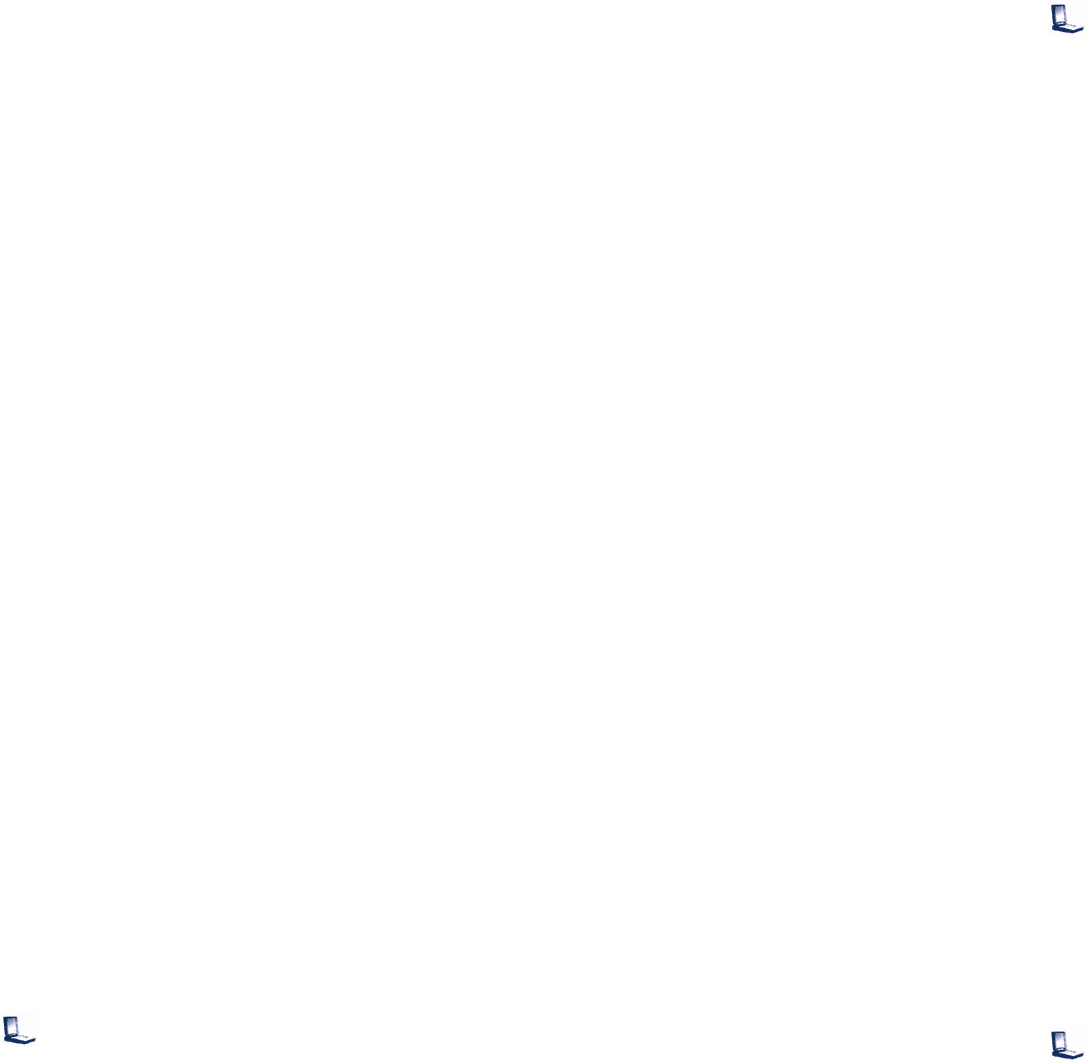
Problems: Developing Engineering Skills 479
mass flow rate of water is 12 kg/s. The turbine and pump
operate adiabatically but not reversibly. Determine
(a) the thermal efficiency.
(b) the rates of heat transfer Q
#
in
and Q
#
out
, each in kW.
8.22 Superheated steam at 8 MPa and 4808C leaves the steam
generator of a vapor power plant. Heat transfer and frictional
effects in the line connecting the steam generator and the
turbine reduce the pressure and temperature at the turbine
inlet to 7.6 MPa and 4408C, respectively. The pressure at the exit
of the turbine is 10 kPa, and the turbine operates adiabatically.
Liquid leaves the condenser at 8 kPa, 368C. The pressure is
increased to 8.6 MPa across the pump. The turbine and pump
isentropic efficiencies are 88%. The mass flow rate of steam
is 79.53 kg/s. Determine
(a) the net power output, in kW.
(b) the thermal efficiency.
(c) the rate of heat transfer from the line connecting the
steam generator and the turbine, in kW.
(d) the mass flow rate of condenser cooling water, in kg/s, if
the cooling water enters at 158C and exits at 358C with
negligible pressure change.
8.23 Water is the working fluid in a Rankine cycle. Steam exits
the steam generator at 1500 lbf/in.
2
and 11008F. Due to heat
transfer and frictional effects in the line connecting the
steam generator and turbine, the pressure and temperature
at the turbine inlet are reduced to 1400 lbf/in.
2
and 10008F,
respectively. Both the turbine and pump have isentropic
efficiencies of 85%. Pressure at the condenser inlet is 2 lbf/in.
2
,
but due to frictional effects the condensate exits the condenser
at a pressure of 1.5 lbf/in.
2
and a temperature of 1108F. The
condensate is pumped to 1600 lbf/in.
2
before entering the steam
generator. The net power output of the cycle is 1 3 10
9
Btu/h.
Cooling water experiences a temperature increase from 608F
to 768F, with negligible pressure drop, as it passes through the
condenser. Determine for the cycle
(a) the mass flow rate of steam, in lb/h.
(b) the rate of heat transfer, in Btu/h, to the working fluid
passing through the steam generator.
(c) the thermal efficiency.
(d) the mass flow rate of cooling water, in lb/h.
8.24 Steam enters the turbine of a vapor power plant at 600 lbf/
in.
2
, 10008F and exits as a two-phase liquid–vapor mixture at
temperature T. Condensate exits the condenser at a
temperature 58F lower than T and is pumped to 600 lbf/in.
2
The turbine and pump isentropic efficiencies are 90 and
80%, respectively. The net power developed is 1 MW.
(a) For T 5 808F, determine the steam quality at the turbine
exit, the steam mass flow rate, in lb/h, and the thermal
efficiency.
(b) Plot the quantities of part (a) versus T ranging from 80
to 1058F.
8.25 Superheated steam at 18 MPa, 5608C, enters the turbine
of a vapor power plant. The pressure at the exit of the
turbine is 0.06 bar, and liquid leaves the condenser at 0.045
bar, 268C. The pressure is increased to 18.2 MPa across the
pump. The turbine and pump have isentropic efficiencies of
82 and 77%, respectively. For the cycle, determine
(a) the net work per unit mass of steam flow, in kJ/kg.
(b) the heat transfer to steam passing through the boiler, in
kJ per kg of steam flowing.
(c) the thermal efficiency.
(d) the heat transfer to cooling water passing through the
condenser, in kJ per kg of steam condensed.
8.26 In the preliminary design of a power plant, water is
chosen as the working fluid and it is determined that the
turbine inlet temperature may not exceed 5208C. Based on
expected cooling water temperatures, the condenser is to
operate at a pressure of 0.06 bar. Determine the steam
generator pressure required if the isentropic turbine
efficiency is 80% and the quality of steam at the turbine exit
must be at least 90%.
Considering Reheat and Supercritical Cycles
8.27 Steam at 10 MPa, 6008C enters the first-stage turbine of an
ideal Rankine cycle with reheat. The steam leaving the reheat
section of the steam generator is at 5008C, and the condenser
pressure is 6 kPa. If the quality at the exit of the second-stage
turbine is 90%, determine the cycle thermal efficiency.
8.28 Water is the working fluid in an ideal Rankine cycle with
superheat and reheat. Steam enters the first-stage turbine
at 1400 lbf/in.
2
and 10008F, expands to a pressure of 350 lbf/in.
2
,
and is reheated to 9008F before entering the second-stage
turbine. The condenser pressure is 2 lbf/in.
2
The net power
output of the cycle is 1 3 10
9
Btu/h. Determine for the
cycle
(a) the mass flow rate of steam, in lb/h.
(b) the rate of heat transfer, in Btu/h, to the working fluid
passing through the steam generator.
(c) the rate of heat transfer, in Btu/h, to the working fluid
passing through the reheater.
(d) the thermal efficiency.
8.29 Water is the working fluid in an ideal Rankine cycle with
reheat. Superheated vapor enters the turbine at 10 MPa,
4808C, and the condenser pressure is 6 kPa. Steam expands
through the first-stage turbine to 0.7 MPa and then is
reheated to 4808C. Determine for the cycle
(a) the rate of heat addition, in kJ per kg of steam entering
the first-stage turbine.
(b) the thermal efficiency.
(c) the rate of heat transfer from the working fluid passing
through the condenser to the cooling water, in kJ per kg of
steam entering the first-stage turbine.
8.30 For the cycle of Problem 8.29, reconsider the analysis
assuming the pump and each turbine stage has an isentropic
efficiency of 80%. Answer the same questions as in Problem
8.29 for the modified cycle.
8.31 Investigate the effects on cycle performance as the reheat
pressure and final reheat temperature take on other values.
Construct suitable plots and discuss for the cycle of
(a) Problem 8.29.
(b) Problem 8.30.
8.32 An ideal Rankine cycle with reheat uses water as the
working fluid. The conditions at the inlet to the first-stage
c08VaporPowerSystems.indd Page 479 7/13/10 12:14:33 PM user-s146 c08VaporPowerSystems.indd Page 479 7/13/10 12:14:33 PM user-s146 /Users/user-s146/Desktop/Merry_X-Mas/New/Users/user-s146/Desktop/Merry_X-Mas/New

480 Chapter 8
Vapor Power Systems
turbine are p
1
5 2500 lbf/in.
2
, T
1
5 10008F. The steam is
reheated at constant pressure p between the turbine stages
to 10008F. The condenser pressure is 1 lbf/in.
2
(a) If p/p
1
5 0.2, determine the cycle thermal efficiency and
the steam quality at the exit of the second-stage turbine.
(b) Plot the quantities of part (a) versus the pressure ratio
p/p
1
ranging from 0.05 to 1.0.
8.33 Steam at 32 MPa, 5208C enters the first stage of a
supercritical reheat cycle including three turbine stages.
Steam exiting the first-stage turbine at pressure p is
reheated at constant pressure to 4408C, and steam exiting
the second-stage turbine at 0.5 MPa is reheated at constant
pressure to 3608C. Each turbine stage and the pump has
an isentropic efficiency of 85%. The condenser pressure is
8 kPa.
(a) For p 5 4 MPa, determine the net work per unit mass
of steam flowing, in kJ/kg, and the thermal efficiency.
(b) Plot the quantities of part (a) versus p ranging from 0.5
to 10 MPa.
8.34 Steam at 4800 lbf/in.
2
, 10008F enters the first stage of a
supercritical reheat cycle including two turbine stages. The
steam exiting the first-stage turbine at 600 lbf/in.
2
is reheated
at constant pressure to 10008F. Each turbine stage and the
pump has an isentropic efficiency of 85%. The condenser
pressure is 1 lbf/in.
2
If the net power output of the cycle is
100 MW, determine
(a) the rate of heat transfer to the working fluid passing
through the steam generator, in MW.
(b) the rate of heat transfer from the working fluid passing
through the condenser, in MW.
(c) the cycle thermal efficiency.
8.35 An ideal Rankine cycle with reheat uses water as the
working fluid. The conditions at the inlet to the first-stage
turbine are 14 MPa, 6008C and the steam is reheated between
the turbine stages to 6008C. For a condenser pressure of 6 kPa,
plot the cycle thermal efficiency versus reheat pressure for
pressures ranging from 2 to 12 MPa.
8.36 An ideal Rankine cycle with reheat uses water as the
working fluid. The conditions at the inlet to the first turbine
stage are 1600 lbf/in.
2
, 12008F and the steam is reheated
between the turbine stages to 12008F. For a condenser pressure
of 1 lbf/in.
2
, plot the cycle thermal efficiency versus reheat
pressure for pressures ranging from 60 to 1200 lbf/in.
2
.
Analyzing Regenerative Cycles
8.37 Water is the working fluid in an ideal regenerative
Rankine cycle. Superheated vapor enters the turbine at 10 MPa,
4808C, and the condenser pressure is 6 kPa. Steam expands
through the first-stage turbine to 0.7 MPa where some of the
steam is extracted and diverted to an open feedwater heater
operating at 0.7 MPa. The remaining steam expands through
the second-stage turbine to the condenser pressure of 6 kPa.
Saturated liquid exits the feedwater heater at 0.7 MPa.
Determine for the cycle
(a) the rate of heat addition, in kJ per kg of steam entering
the first-stage turbine.
(b) the thermal efficiency.
(c) the rate of heat transfer from the working fluid passing
through the condenser to the cooling water, in kJ per kg of
steam entering the first-stage turbine.
8.38 For the cycle of Problem 8.37, reconsider the analysis
assuming the pump and each turbine stage has an isentropic
efficiency of 80%. Answer the same questions as in Problem
8.37 for the modified cycle.
8.39 Investigate the effects on cycle performance as the
feedwater heater pressure takes on other values. Construct
suitable plots and discuss for the cycle of
(a) Problem 8.37.
(b) Problem 8.38.
8.40 A power plant operates on a regenerative vapor power
cycle with one open feedwater heater. Steam enters the first
turbine stage at 12 MPa, 5208C and expands to 1 MPa, where
some of the steam is extracted and diverted to the open
feedwater heater operating at 1 MPa. The remaining steam
expands through the second turbine stage to the condenser
pressure of 6 kPa. Saturated liquid exits the open feedwater
heater at 1 MPa. For isentropic processes in the turbines and
pumps, determine for the cycle (a) the thermal efficiency
and (b) the mass flow rate into the first turbine stage, in
kg/h, for a net power output of 330 MW.
8.41 Reconsider the cycle of Problem 8.40 as the feedwater
heater pressure takes on other values. Plot the thermal
efficiency and the rate of exergy destruction within the
feedwater heater, in kW, versus the feedwater heater pressure
ranging from 0.5 to 10 MPa. Let T
0
5 293 K.
8.42 Compare the results of Problem 8.40 with those for an
ideal Rankine cycle having the same turbine inlet conditions
and condenser pressure, but no regenerator.
8.43 For the cycle of Problem 8.40, investigate the effects on
cycle performance as the feedwater heater pressure takes on
other values. Construct suitable plots and discuss. Assume
that each turbine stage and each pump has an isentropic
efficiency of 80%.
8.44 Water is the working fluid in an ideal regenerative Rankine
cycle with one open feedwater heater. Steam enters the turbine
at 1400 lbf/in.
2
and 10008F and expands it to 120 lbf/in.
2
, where
some of the steam is extracted and diverted to the open
feedwater heater operating at 120 lbf/in.
2
The remaining
steam expands through the second-stage turbine to the
condenser pressure of 2 lbf/in.
2
Saturated liquid exits the open
feedwater heater at 120 lbf/in.
2
The net power output of the
cycle is 1 3 10
9
Btu/h. Determine for the cycle
(a) the mass flow rate of steam entering the first stage of the
turbine, in lb/h.
(b) the rate of heat transfer, in Btu/h, to the working fluid
passing through the steam generator.
(c) the thermal efficiency.
8.45 Water is the working fluid in a regenerative Rankine cycle
with one open feedwater heater. Steam enters the turbine at
1400 lbf/in.
2
and 10008F and expands to 120 lbf/in.
2
, where
some of the steam is extracted and diverted to the open
feedwater heater operating at 120 lbf/in.
2
The remaining steam
expands through the second-stage turbine to the condenser
c08VaporPowerSystems.indd Page 480 7/12/10 7:02:08 AM user-s146 c08VaporPowerSystems.indd Page 480 7/12/10 7:02:08 AM user-s146 /Users/user-s146/Desktop/Merry_X-Mas/New/Users/user-s146/Desktop/Merry_X-Mas/New

Problems: Developing Engineering Skills 481
pressure of 2 lbf/in.
2
Each turbine stage and both pumps have
isentropic efficiencies of 85%. Flow through the condenser,
open feedwater heater, and steam generator is at constant
pressure. Saturated liquid exits the open feedwater heater at
120 lbf/in.
2
The net power output of the cycle is 1 3 10
9
Btu/h.
Determine for the cycle
(a) the mass flow rate of steam entering the first stage of the
turbine, in lb/h.
(b) the rate of heat transfer, in Btu/h, to the working fluid
passing through the steam generator.
(c) the thermal efficiency.
8.46 Water is the working fluid in an ideal regenerative Rankine
cycle with one open feedwater heater. Superheated vapor
enters the first-stage turbine at 16 MPa, 5608C, and the
condenser pressure is 8 kPa. The mass flow rate of steam
entering the first-stage turbine is 120 kg/s. Steam expands
through the first-stage turbine to 1 MPa where some of the
steam is extracted and diverted to an open feedwater heater
operating at 1 MPa. The remainder expands through the second-
stage turbine to the condenser pressure of 8 kPa. Saturated
liquid exits the feedwater heater at 1 MPa. Determine
(a) the net power developed, in kW.
(b) the rate of heat transfer to the steam passing through the
boiler, in kW.
(c) the thermal efficiency.
(d) the mass flow rate of condenser cooling water, in kg/s, if the
cooling water undergoes a temperature increase of 188C with
negligible pressure change in passing through the condenser.
8.47 Reconsider the cycle of Problem 8.46, but include in the
analysis that each turbine stage and the pump has an isentropic
efficiency of 85%.
8.48 For the cycle of Problem 8.47, investigate the effects on
cycle performance as the feedwater heater pressure takes on
other values. Construct suitable plots and discuss.
8.49 Water is the working fluid in an ideal regenerative
Rankine cycle with one closed feedwater heater. Superheated
vapor enters the turbine at 10 MPa, 4808C, and the condenser
pressure is 6 kPa. Steam expands through the first-stage
turbine where some is extracted and diverted to a closed
feedwater heater at 0.7 MPa. Condensate drains from the
feedwater heater as saturated liquid at 0.7 MPa and is
trapped into the condenser. The feedwater leaves the heater
at 10 MPa and a temperature equal to the saturation
temperature at 0.7 MPa. Determine for the cycle
(a) the rate of heat transfer to the working fluid passing
through the steam generator, in kJ per kg of steam entering
the first-stage turbine.
(b) the thermal efficiency.
(c) the rate of heat transfer from the working fluid passing
through the condenser to the cooling water, in kJ per kg of
steam entering the first-stage turbine.
8.50 For the cycle of Problem 8.49, reconsider the analysis
assuming the pump and each turbine stage have isentropic
efficiencies of 80%. Answer the same questions as in Problem
8.49 for the modified cycle.
8.51 For the cycle of Problem 8.50, investigate the effects on cycle
performance as the extraction pressure takes on other values.
Assume that condensate drains from the closed feedwater
heater as saturated liquid at the extraction pressure. Also,
feedwater leaves the heater at 10 MPa and a temperature
equal to the saturation temperature at the extraction
pressure. Construct suitable plots and discuss.
8.52 A power plant operates on a regenerative vapor power
cycle with one closed feedwater heater. Steam enters the
first turbine stage at 120 bar, 5208C and expands to 10 bar,
where some of the steam is extracted and diverted to a
closed feedwater heater. Condensate exiting the feedwater
heater as saturated liquid at 10 bar passes through a trap
into the condenser. The feedwater exits the heater at 120 bar
with a temperature of 1708C. The condenser pressure is
0.06 bar. For isentropic processes in each turbine stage and
the pump, determine for the cycle (a) the thermal efficiency
and (b) the mass flow rate into the first-stage turbine, in
kg/h, if the net power developed is 320 MW.
8.53 Reconsider the cycle of Problem 8.52, but include in the
analysis that each turbine stage has an isentropic efficiency
of 82%. The pump efficiency remains 100%.
8.54 Modify the cycle of Problem 8.49 such that the saturated
liquid condensate from the feedwater heater at 0.7 MPa is
pumped into the feedwater line rather than being trapped
into the condenser. Answer the same questions about the
modified cycle as in Problem 8.49. List advantages and
disadvantages of each scheme for removing condensate from
the closed feedwater heater.
8.55 Water is the working fluid in an ideal regenerative
Rankine cycle with one closed feedwater heater. Steam
enters the turbine at 1400 lbf/in.
2
and 10008F and expands
to 120 lbf/in.
2
, where some of the steam is extracted and
diverted to the closed feedwater heater. The remaining
steam expands through the second-stage turbine to the
condenser pressure of 2 lbf/in.
2
Condensate exiting the
feedwater heater as saturated liquid at 120 lbf/in.
2
undergoes
a throttling process as it passes through a trap into the
condenser. The feedwater leaves the heater at 1400 lbf/in.
2
and a temperature equal to the saturation temperature at
120 lbf/in.
2
The net power output of the cycle is 1 3 10
9
Btu/h.
Determine for the cycle
(a) the mass flow rate of steam entering the first stage of the
turbine, in lb/h.
(b) the rate of heat transfer, in Btu/h, to the working fluid
passing through the steam generator.
(c) the thermal efficiency.
8.56 Water is the working fluid in a regenerative Rankine
cycle with one closed feedwater heater. Steam enters the
turbine at 1400 lbf/in.
2
and 10008F and expands to 120 lbf/
in.
2
, where some of the steam is extracted and diverted to
the closed feedwater heater. The remaining steam expands
through the second-stage turbine to the condenser pressure
of 2 lbf/in.
2
Each turbine stage and the pump have isentropic
efficiencies of 85%. Flow through the condenser, closed
feedwater heater, and steam generator is at constant pressure.
Condensate exiting the feedwater heater as saturated liquid at
120 lbf/in.
2
undergoes a throttling process as it passes through
a trap into the condenser. The feedwater leaves the heater at
1400 lbf/in.
2
and a temperature equal to the saturation
c08VaporPowerSystems.indd Page 481 7/12/10 7:02:08 AM user-s146 c08VaporPowerSystems.indd Page 481 7/12/10 7:02:08 AM user-s146 /Users/user-s146/Desktop/Merry_X-Mas/New/Users/user-s146/Desktop/Merry_X-Mas/New
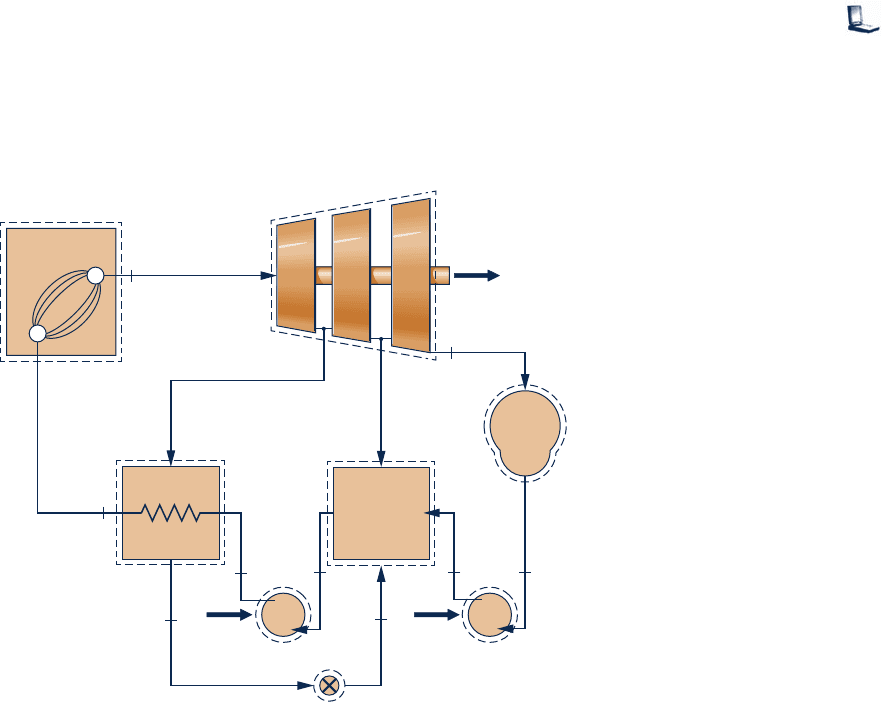
482 Chapter 8
Vapor Power Systems
temperature at 120 lbf/in.
2
The net power output of the cycle
is 1 3 10
9
Btu/h. Determine for the cycle
(a) the mass flow rate of steam entering the first stage of the
turbine, in lb/h.
(b) the rate of heat transfer, in Btu/h, to the working fluid
passing through the steam generator.
(c) the thermal efficiency.
8.57 Water is the working fluid in an ideal regenerative
Rankine cycle with one closed feedwater heater. Superheated
vapor enters the turbine at 16 MPa, 5608C, and the condenser
pressure is 8 kPa. The cycle has a closed feedwater heater
using extracted steam at 1 MPa. Condensate drains from the
feedwater heater as saturated liquid at 1 MPa and is trapped
into the condenser. The feedwater leaves the heater at 16 MPa
and a temperature equal to the saturation temperature at
1 MPa. The mass flow rate of steam entering the first-stage
turbine is 120 kg/s. Determine
(a) the net power developed, in kW.
(b) the rate of heat transfer to the steam passing through the
boiler, in kW.
(c) the thermal efficiency.
(d) the mass flow rate of condenser cooling water, in kg/s, if the
cooling water undergoes a temperature increase of 188C with
negligible pressure change in passing through the condenser.
8.58 Reconsider the cycle of Problem 8.57, but include in the
analysis that the isentropic efficiencies of the turbine stages
and the pump are 85%.
8.59 Referring to Fig. 8.12, if the fractions of the total flow
entering the first turbine stage (state 1) extracted at states
2, 3, 6, and 7 are y
2
, y
3
, y
6
, and y
7
, respectively, what are the
fractions of the total flow at states 8, 11, and 17?
8.60 Consider a regenerative vapor power cycle with two
feedwater heaters, a closed one and an open one, as shown
in Figure P8.60. Steam enters the first turbine stage at 12 MPa,
4808C, and expands to 2 MPa. Some steam is extracted at 2 MPa
and fed to the closed feedwater heater. The remainder
expands through the second-stage turbine to 0.3 MPa, where
an additional amount is extracted and fed into the open
feedwater heater operating at 0.3 MPa. The steam expanding
through the third-stage turbine exits at the condenser
pressure of 6 kPa.
Feedwater leaves the closed heater at 2108C, 12 MPa, and
condensate exiting as saturated liquid at 2 MPa is trapped into
the open feedwater heater. Saturated liquid at 0.3 MPa leaves
the open feedwater heater. Assume all pumps and turbine
stages operate isentropically. Determine for the cycle
(a) the rate of heat transfer to the working fluid passing
through the steam generator, in kJ per kg of steam entering
the first-stage turbine.
(b) the thermal efficiency.
(c) the rate of heat transfer from the working fluid passing
through the condenser to the cooling water, in kJ per kg of
steam entering the first-stage turbine.
8.61 For the cycle of Problem 8.60, reconsider the analysis
assuming the pump and each turbine stage has an isentropic
efficiency of 80%. Answer the same questions as in Problem
8.60 for the modified cycle.
8.62 For the cycle of Problem 8.60, investigate the effects on
cycle performance as the higher extraction pressure takes on
other values. The operating conditions for the open feedwater
heater are unchanged from those in Problem 8.60. Assume
that condensate drains from the closed feedwater heater as
saturated liquid at the higher extraction pressure. Also,
Steam
generator
W
t
·
W
p1
·
Condenser
6 kPa
4
3
2
1
m
.
1
= 1.5 × 10
4
kg/s
T
1
= 480°C
p
1
= 12 MPa
T
9
= 210°C
9
10 11
65
87
Pump 2 Pump 1
Closed
heater
Open
heater
0.3 MPa
2.0 MPa
Trap
Sat.
liquid
Sat.
liquid
W
p2
·
p
9
= 12 MPa
Fig. P8.60
c08VaporPowerSystems.indd Page 482 7/12/10 7:02:09 AM user-s146 c08VaporPowerSystems.indd Page 482 7/12/10 7:02:09 AM user-s146 /Users/user-s146/Desktop/Merry_X-Mas/New/Users/user-s146/Desktop/Merry_X-Mas/New
